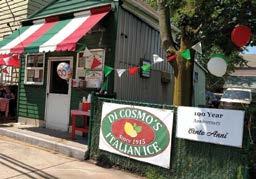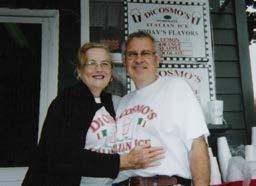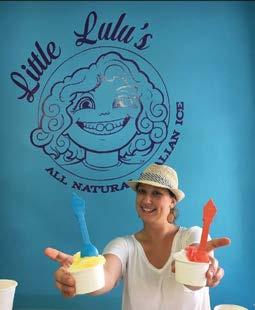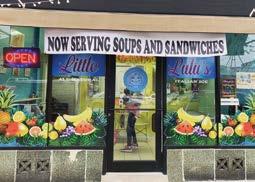
13 minute read
Pagina Italiana
L’Uomo che assomigliava a La Russa
TRANSLATED BY SERENA LONIGRO
Advertisement
Continua dall’edizione primaverale ...
Dopo la prima lezione di Storia americana del Prof. Massaro, portai la nota al Da Alberto - Ristorante Italiano, il ristorante che mio padre aveva aperto vent’anni prima, all’inizio degli anni ‘70. Mio padre - Alberto, il cui nome era inciso sulla tenda da sole dell’ingresso - dirigeva la cucina. Mia madre, Patricia, era direttrice di sala, accoglieva i clienti che entravano e non dimenticava mai neanche un nome. Io lavoravo dopo scuola e nei weekend, sparecchi avo e lavavo i piatti, qualche volta servivo persino ai tavoli se una delle cameriere mi chiamava. Arrivavo al ristorante verso le tre e mezza del pomeriggio, facevo i compiti per circa un’ora prima che arrivassero i primi clienti.
Il mio primo incarico alla scuola superiore fu quello di far firmare la nota del Prof. Massaro, così la portai a mio padre che era in cucina a preparare l’impasto per le pizze. Gli mostrai la nota e gli dissi perchè l’avevo ricevuta.
“Ah, Lou,” disse, scrutando la nota mentre continuava a lavorare l’impasto, con le mani coperte di farina. “Insegna ai ragazzi com’è veramente. Buon per lui.”
Guardai mio padre come per chiedere, ‘Okay, quindi la firmerai?’
“Mi ricorda di com’era per noi,” disse. “Molto tempo fa.” Guardò la nota e fece un cenno col capo. “Portala a tua madre, falla firmare a lei.”
Il giorno seguente, portai la nota in classe, ma Britney Finley non aveva fatto lo stesso.
“Mio padre dice che non avrei dovuto avere uno zero,” disse al Prof. Massaro dinanzi a tutta la classe. “Dice che
TasteLittleItaly.com
non è giusto visto che non abbiamo ancora fatto neanche il compito.”
“Se non hai la nota firmata,” disse il Prof. Massaro, “non potrai fare alcun compito in classe, e allora zero sarà il voto definitivo.”
“Non è giusto!” urlò Britney.
“No,” disse il Prof. Massaro. “Non lo è. E non alzare mai più la voce nella mia classe.”
Quando finirono le lezioni, mi fermai al mio armadietto, misi i libri nello zaino e uscii, andai a prendere l’autobus che mi avrebbe portato al ristorante. Mentre attraversavo le porte a vetri della scuola, vidi il Prof. Massaro affrontare un uomo che immaginai essere il padre di Britney. Lei gli stava accanto mentre lui urlava al Prof. Massaro.
Il Prof. Massaro se ne stava lì, impassibile. Quando un po’ della saliva del Sig. Finley gli colpì il viso, lui si asci ugò con calma con la manica della camicia. Poi aprì la sua cartella e ne tirò fuori un foglio di carta.
Mentre gli passai accanto, intravidi un angolo del foglio e lo riconobbi immediatamente. Era il modulo di domanda per lavorare Da Alberto. Guardai il Prof. Massaro, il quale accennò un sorriso verso di me, mentre tendeva il modulo al padre di Britney.
“Ecco il modo migliore per sua figlia di imparare la Storia Americana,” sentii dire al Prof. Massaro. “Può iniziare lavorando.”
Mi diressi verso il mio autobus e mentre attendevo seduto che il conducente chiudesse le porte, pensai a tutti i moduli che il Prof. Massaro aveva chiesto negli anni. Mi chiesi se qualcuno degli studenti a cui li avesse dati faceva parte della schiera di liceali che avevano lavorato al ristorante negli anni. Mi chiesi se Britney avrebbe effet tivamente compilato la domanda e si sarebbe presentata al lavoro.
Ma ancora di più, mi chiesi cosa intendesse mio padre quando diceva “Una vita fa.” E per quale motivo il Prof. Massaro quel giorno stesse piangendo.
Italian Gift Packages (650) 867-2919
Authentic • Traditional • Innovative Serena Lonigro was born and raised in Napoli. She graduated from the University of Naples “L’Orientale” with a degree in Foreign Languages and Literatures and now works in marketing and news media.
The Man Who Looked Like La Russa
BY MILES RYAN FISHER
Continued from the spring issue …
After the first day of Mr. Massaro’s U.S. History class, I took the form to Alberto’s Italian Restaurant, the res taurant my father had opened twenty years ago, back in the early 1970s. My father—the Alberto whose name was on the awning—oversaw the kitchen. My mother, Patricia, was the hostess, greeting guests as they entered and never forgetting a name. I worked after school and on weekends, still bussing tables and washing dishes and now sometimes waiting tables if one of the waitresses called out. I’d get to the restaurant by three-thirty in the afternoon and work on my homework for an hour before the early customers started to arrive.
My very first high school assignment was to get Mr. Massaro’s form signed, so I took it to my father while he was in the kitchen prepping dough for the pizzas. I held the form up to him and told him what it was for.
“Ah, Lou,” he said, peering at the form as he continued kneading the dough, his hands covered in flour. “Teaching kids what it’s really like. Good for him.”
I looked at my dad, as if to ask, ‘So then you’ll sign it?’
“Reminds me of what it was like for us,” he said. “Way back before.” He looked at the form and nodded. “Take it to your mother and have her sign it.”
The next day, I brought the form into class. Britney Finley did not.
“My daddy says I shouldn’t have a zero,” she told Mr. Massaro in front of the whole class. “He says it’s not fair when we haven’t even taken a test yet.”
“If you don’t have the form signed,” Mr. Massaro said, “then you won’t be able to take any tests, and you’ll have a permanent zero.”
“But that’s not fair!” Britney yelled.
“No,” Mr. Massaro said. “It isn’t. And do not raise your voice in my classroom again.”
After the school day ended, I stopped by my locker, filled my backpack with books, and walked out toward the bus that would take me to the restaurant. On my way through the school’s glass doors, I saw Mr. Massaro facing a man whom I assumed was Britney’s father. She stood at his side as he shouted at Mr. Massaro.
Mr. Massaro stood there, unperturbed. After some of Mr. Finley’s saliva struck his face, he calmly wiped it off with the sleeve of his shirt. Then he opened his satchel and took out a sheet of paper.
As I walked by, I caught a glimpse of the paper and recognized it right away. It was an application to work at Alberto’s. I looked at Mr. Massaro, who smiled slightly while giving me a cursory glance as he held out the ap plication for Britney’s father.
“Here’s a better way for your daughter to learn U.S. History,” I heard Mr. Massaro say. “She can begin by working.”
I got on my bus and as I sat, waiting for the driver to pull the bus doors shut, I thought about the applications Mr. Massaro had asked for those past years. I wondered if any of the students he’d given them to had been the high school students who’d worked at the restaurant. I wondered if Britney would actually fill out the application and show up to work.
But more so, I wondered just what my father meant when he’d said, “Way back before.” And what it was about that time that made Mr. Massaro weep.
Adopt an Olive Tree for one year from our groves in Calabria, Italy and we will send you the extra virgin olive oil from your tree after harvest. You will also receive photos of your tree, an adoption certificate and your tree is tagged with your name for the year!






Italian Ice
The Treat that Beats the Heat

(Anna Om)
BY CHUCK PECORARO
Back in 17 th century Sicily, whenever the summer sun sent the temperature soaring, the locals sought to beat the heat with a simple but satisfying treat. They gathered snow from the upper levels of Mount Etna, infused it with fruit or wine, and relished what then was referred to as water ice. According to historians, Roman Emperor Nero ordered his slaves to climb the mountain and fetch snow for him to make icy morsels and cool his drinks.
The refreshment and its uncomplicated recipe eventu ally caught on in other regions of Italy as well as Greece, France, Spain, and Great Britain. What’s more, cultures ranging from Turkish and Arabic to Chinese claimed that the frozen tidbits had found a way into their respective diets, too.
Thus, Europe and various parts of the world became familiar with what is now known as Italian ice. Not to be confused with granita or sorbet, the cool concoction later made its debut in the United States when it was introduced by Italian immigrants who’d settled primarily in the Northeast.
One of the pioneers of Italian ice is Caterina Di Cosmo, who emigrated from Italy to an Italian-American enclave in Peterstown, New Jersey. She and her husband, Giovanni, opened Di Cosmo’s, a neighborhood grocery, in 1915 that became a destination for the frosty favorite. When sales multiplied, they expanded with an adjoining shack made from salvaged wood that exclusively featured the product.

Di Cosmo’s Italian Ice of Elizabeth, New Jersey, celebrated its 100th anniversary in 2015. (Photo Courtesy of Di Cosmo’s Italian Ice)
Nancy and John Di Cosmo, who have helped run Di Cosmo’s for half a century. (Photo Courtesy of Di Cosmo’s Italian Ice)

The Di Cosmo’s version came out smooth and less granular than granita, and was accented with the tart tone of freshly squeezed lemons. It was not only an instant hit with the townsfolk, but also with visitors who came from far and wide.
Fast forward to today, and the same shop remains in the family. The ice used to make the blend is no longer shipped via horse and buggy in 300-pound blocks, but by modern vehicles. Production equipment has likewise seen its share of changes.
Nancy Di Cosmo, who married into the family in 1969, helps run the third-generation operation with her husband, John. They begin each morning with a fresh delivery of ice, fruit, and juices from local New Jersey suppliers, and they proceed to craft a rotating menu of at least two dozen flavors. Customers keep coming back with their children and grandchildren in tow.
Stored in 100-year-old wooden barrels, the soothing slush is relatively easy to prepare. The fruit is zested, sliced, and juiced by hand. Then cane sugar is added and the contents are churned before being poured into a stainlesssteel tube nestled in a barrel filled with cracked ice and rock salt. The salt lowers the freezing point so the finished product maintains an ideal temperature throughout the day. Flavors are determined by whatever fruit is in season.
Among the Di Cosmos’ legion of loyal customers is celebrity chef and Elizabeth, New Jersey-native Tom Col icchio, who said, “Italian ice was part of my childhood. My summers weren’t complete unless I went there at least once a week. That’s why everybody who grew up eating Italian ice keeps coming back for more.”
Another example of Italian ice’s transition from humble beginnings to nationwide acceptance is due to Bob Tumolo. The former Philadelphia firefighter started selling it from his porch in Bensalem, Pennsylvania, dur ing the scorching summer of 1984. When sales took off, he formed a company and named it after his wife, Rita. After thriving at three Philadelphia sites, Rita’s Italian Ice was franchised and expanded to more than 600 locations across the country.
Rita’s formula focuses on freshness. Whatever isn’t sold after 36 hours is discarded. The flavors and consistency are preserved by adding chunks of fresh fruit.
The demand for Italian ice in the U.S. continues to grow as it is passed down from generation to generation. In the greater New York City area, the product is available at 28 different locations. By comparison, Chicago and surrounding suburbs has 16 locations.
Common flavors include lemon (often called lemon ice), orange, peach, watermelon, strawberry, cherry, and coffee. Among the more exotic tastes are mango, guava, green tea, and tamarind.
One of them is Little Lulu’s, where handcrafted artisan Italian ice is offered year-round. That’s unique considering that Chicago is noted for frigid winters, and slurping on frozen treats in freezing weather doesn’t ap peal to everyone. Established in 1916, Little Lulu’s is a one-woman operation in an ever-changing neighborhood with residents of various nationalities.

One of the first Rita’s Water Ice locations that were opened in Philadelphia. (Photo Courtesy of Rita’s Water Ice)

Owner/Manager/Creator Autumn Bastyr says she became infatuated with Italian ice at a young age and experimented with flavors and methods until she had an opportunity to become an entrepreneur and go into busi ness for herself. She named her venture after the spunky comic book character Lulu Moppett.
Bastyr’s ice is fluffy, unlike granita and other versions with granular flakes. Her creations capture the ripe, radiant essence of fresh fruit. Flavors range from typical ones like lemon, watermelon, and coconut to more unusual ones like pumpkin and pomegranate. She also stocks Lulupops, which are made with the same base and frozen on a stick.
On the West Coast, Los Angeles and San Francisco are populated with a substantial core of Italian Americans who form a primary market for Italian ice. Los Angeles has 27 places where one can find it, while San Francisco has at least a dozen such shops. Both areas include a Rita’s.
But you don’t have to search here and there for Italian ice that melts in your mouth. It’s easy to whip up a batch
Chuck Pecoraro has been writing about food, wine and travel for more than 30 years, a total of over 1,600 such articles for the Chicago Sun-Times and other prominent publications and websites.
Little Lulu’s owner, Autumn Bastyr. (Photo Courtesy of Little Lulu’s)
right at home, especially in the dog days of summer.

Italian Ice Recipe
(4 cups)
* 3 cups of ice. * 2 cups of fresh fruit, chopped. * 2 to 4 tablespoons of granulated sugar or honey. * 1 tablespoon of fresh lemon juice.
1. Put fruit, juice, sugar and 2 cups of ice in food processor bowl or blender. 2. Blend until chunky, then add remaining ice. Blend until smooth. 3. Pour into a baking dish and place in freezer for 30 minutes. 4. After 30 minutes, remove from freezer and scrape with a fork until slushy. Put back in freezer for 2 more hours. 5. After 2 hours, pour ice into cups. Let them sit for 5 minutes until it softens, or put in blender until it forms a slushy consistency. 6. Scoop, serve and savor
Little Lulus: Chicago’s Little Lulu’s Italian Ice was originally opened in 1916. (Photo Courtesy of Little Lulu’s)










